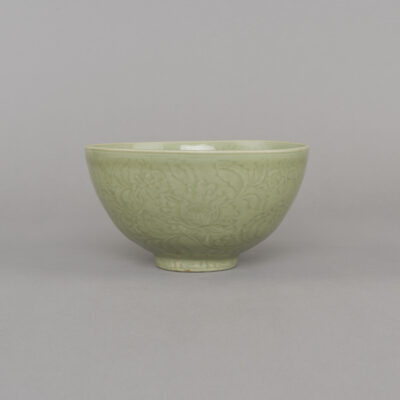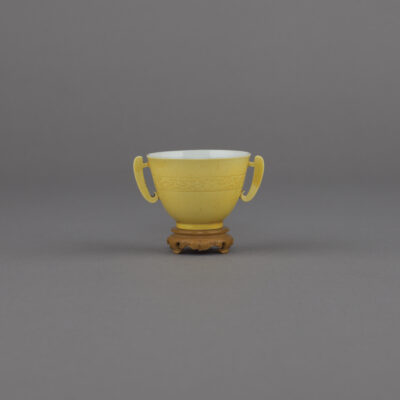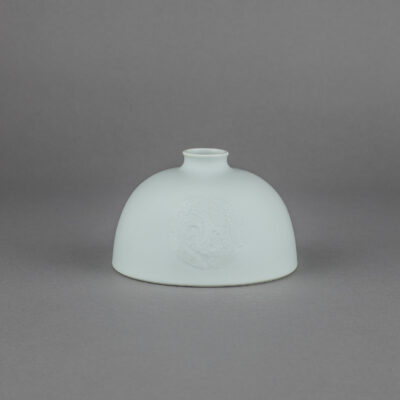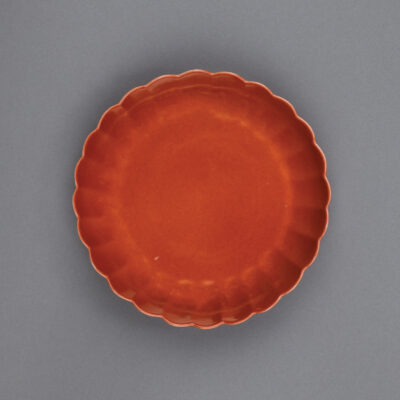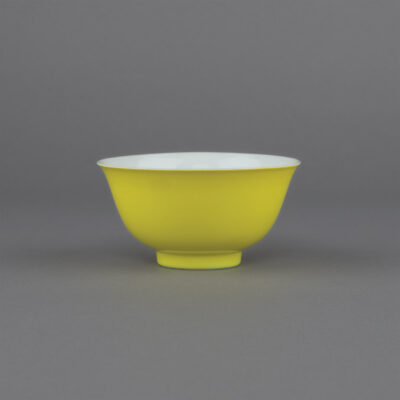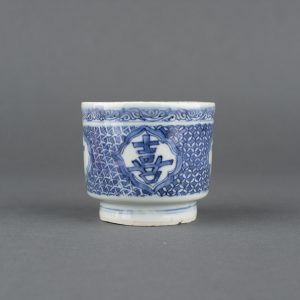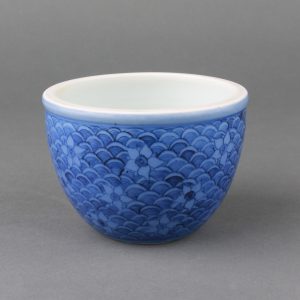
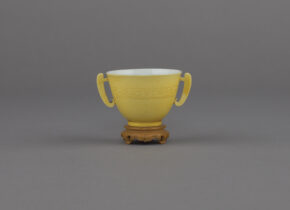
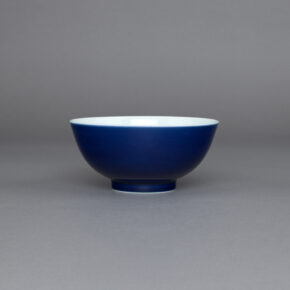
Monochromes
From the Greek monokhromos, mono – one, khromos – colour, Chinese monochrome porcelain is considered to be one of the ceramic world’s great achievements.
Chinese monochrome porcelain is said to have its roots in the Song dynasty (960 – 1279). At the turn of the first millennium, China was the world’s most advanced civilisation and this epoch is known for the invention of movable type printing, bank notes, gunpowder, the compass and even the concept of the restaurant.
Early Chinese monochromes were black and white but very quickly, competition emerged. Kilns vied with each other to see who could make the most exquisite pieces of monochrome Chinese porcelain. In the Song dynasty, the emergence of Ge ware, Guan ware, Ru ware and Jun ware enabled a new burst of colour to appear within the ceramic production.
As the Song dynasty made way for the Yuan, dramatic advancements in the production of Chinese monochrome vases and indeed all forms of Chinese monochromes were developed.
While the production of monochrome Chinese porcelain continued throughout the Yuan dynasty, the Ming dynasty was when new glazing techniques were established. In the Ming dynasty, the most popular monochrome colours used by the imperial court were yellow, red and blue.
When the Qing dynasty arrived, monochromes were very much loved by the emperor and the court. New innovations within the Qing dynasty saw the arrival of new glazes such as peachbloom, teadust, robin’s egg, celadon and lavender, with Song-inspired glazes re-emerging such as Ge, Guan and Ru ware. Further development of enamelled glazes produced remarkable colours not seen before, such as pink, ruby, lemon-yellow, pale turquoise and lime-green.
-

M4896
£68,000Chinese longquan celadon thinly potted deep bowl, carved on the exterior with four different flower-heads of lotus, tree peony, chrysanthemum and peony, on a continuous leafy scrolling branch above a keyfret band at the foot, the interior similarly carved, encircling a single peony branch in the well of the interior, the base glazed with a burnt red ring from the firing.
-

2 – M5253
£POAChinese imperial porcelain yellow-glazed two-handled wine cup, erbei, thinly potted and incised on each side with a continuous anhua band of archaic style dragons facing each other with open mouths, between a pearl, all on a short foot rim and covered overall in an even pale-yellow glaze, pooling on the foot rim between two upright loop handles with curled ends, the interior glazed white.
-

4 – M5388
£POAChinese imperial porcelain white-glazed waterpot of beehive form, taibaizun, with gently flared lipped rim, moulded and carved with three relief archaic style dragon and phoenix medallions, covered overall in an even sweet-white glaze. The base with a six-character mark of Kangxi in underglaze blue and of the period, 1662-1722.
-

11 – R1278
£POAChinese imperial porcelain coral-red ground chrysanthemum-form flower dish, ju ban pan, the body with fluted petals and slightly inverted foot, covered overall in a rich and even coral-red enamel.
-

12 – M5283
£POAChinese imperial porcelain lemon-yellow enamelled deep bowl, wan, thinly potted with gently flared rim and straight foot, covered overall in a rich and even lemon-yellow glaze, the interior glazed white.
-

M4703
£POAChinese imperial porcelain celadon glazed deep bowl with flared rim, carved on the exterior with six camellia flowers on a continuous scrolling branch with leaves, covered overall and extending on the interior and base with a luminous celadon glaze.
-

M5791
£68,000Chinese porcelain imperial bowl with deep rounded sides rising from a short straight foot, covered overall in an even blue glaze, the base with a six-character mark of Kangxi within a double-ring in underglaze blue and of the period.
-

20 – M5145
£POAChinese imperial porcelain large celadon-glazed moulded and carved deep bowl, wan, with flared white-glazed rim and slightly inverted foot decorated on the exterior with large sprays of lotus flowers, leaves and buds, fruiting peach branch, peonies, a pink flower, finger citron, prunus, camellia, fruiting pomegranate, tree peony and fruiting lychee, covered overall in a rich and even luminous celadon glaze, extending to the interior and the base.
-

26 – M4491/2
£POAPair of Chinese imperial porcelain lavender-glazed altar vessels and covers, dou, each modelled after an archaic bronze with moulded and carved archaic designs, the upright body with ribs and bands all on a splayed, ribbed foot, the cover with a design of scrolls, fretwork and two registers of stylised waves beneath a double-rope twist openwork finial, covered overall including the interior and underside in a luminous, rich and even lavender glaze, all the rims dressed in brown in veneration of the archaic prototype.
-

28 – M5538
£POAPair of Chinese imperial porcelain large moulded celadon-glazed bowls, wan, of deep form with upright sides and straight footrims, each moulded on the exterior with six peony blooms on their characteristic leafy branches beneath an archaic scrolling band at the rim and above a keyfret band at the foot, the interior incised overall with a central peony flowerhead encircled by six further blooms on a continuous scrolling branch with leaves beneath a keyfret band at the rim, the rims glazed white, covered overall in a luminous even pale celadon glaze.
-

R1415
£38,500Chinese porcelain stem bowl, covered over all with an eel-skin glaze, finely potted with shallow sides rising to an everted rim, resting on a splayed foot beneath a raised rib, the underside of the foot carved with a three-character mark of Zhi ben tang.
-

S2519
£POAA fine and rare Chinese imperial porcelain brown-glazed dish with foliate rim on a splayed foot, the underside with a central double rib, covered overall in a rich and even bright coffee-brown glaze.
-

1. M5340
£18,500Chinese biscuit porcelain aubergine-glazed teapot and cover of bamboo form with fluted naturalistic body, handle and spout, the cover with an openwork bamboo branch-form handle, the flat base unglazed.
-

2. M5339
£18,500Chinese biscuit porcelain apple-green glazed teapot and cover of bamboo form with fluted naturalistic body, handle and spout, the cover with an openwork bamboo branch form handle, the flat base unglazed.
-

11. M5358
£2,500Chinese turquoise glazed biscuit porcelain joss stick holder modelled as a seated Budai, his right hand holding a bead necklace on his raised knee while his left hand holds a treasure sack, covered overall in a rich even turquoise glaze pooling at the edges.
-

12. M5361
£4,500Pair of Chinese biscuit porcelain turquoise-glazed brushwashers, each in the form of Budai with their outstretched arms encircling the aperture, covered in a rich turquoise glaze, the base unglazed.
-

13. M5362
£3,200Chinese biscuit porcelain turquoise glazed water-dropper in the form of a seated monkey holding a gourd, his body carved with hairwork and sitting on a rockwork base.
-

14. M5359
£3,800Chinese biscuit porcelain turquoise and aubergine glazed water-dropper in the form of a Mandarin duck beside a large lotus leaf with the veins in relief, the dropper in the form of a stalk, the duck with carved wings and tail feathers.
Further information on Monochromes
Chinese monochromes took a starring role in state ceremonies because traditional Chinese beliefs assumed that ritual vessels must be Chinese monochromes of glazed porcelain of particular colours, representative of four temples in Beijing and the gods they represented:
Blue Chinese monochrome porcelain – Altar of Heaven (tiantan)
Yellow Chinese monochrome porcelain – Altar of the Earth (ditan)
White Chinese monochrome porcelain – Altar of the Moon (yuetan)
Red Chinese monochrome porcelain – Altar of the Sun (ritan)
The reign of Kangxi at the start of the Qing dynasty was when the techniques of Chinese monochromes began to mature.
The beauty of Chinese monochrome vases, indeed all Chinese monochrome porcelain was in the technical accomplishment, the finesse of the colours and the quality of the glaze. It’s testament to the processes developed to produce monochrome Chinese porcelain that the colours have remained as spectacular as they were the day they were fired.
Arguably the most famous of all the colours, not just of Chinese monochrome porcelain but of all Chinese porcelain, blue is almost infinitely varied and the cobalt used came from as far away as modern-day Iran – from the most pale clair de lune to the deepest shades known as Mazarine blue.



